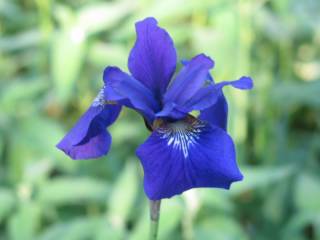Ouch!
-
As in, I'm sore!A week ago, the New Millennium Delphiniums I ordered from Graceful Gardens arrived, and yesterday I was finally able to get them in the ground.
But before that could happen, the ground needed preparation, and so there was much weeding, followed by soil turning, followed by the addition of soil amendments (composted manure, leaf mold and a granular high-phosphorus fertilizer), followed by more soil turning.
It was an absolutely perfect day to work in the garden, as the temperature stayed around 65ºF and overcast, with a chance of showers later in the day. So after all the digging and bending and stooping of bed prep, I was able to plant 32 Delphiniums, 10 Crocosmia corms, 5 orange daylilies mailed to me by a gardening friend in Arkansas (she calls them "ditch lilies"), and a recent impulse purchase from Lowe's -- a bronze-colored New Zealand flax.
I watered everything in well, and then last night Mother Nature was gracious enough to water everything again, and she's continuing to do so, today. Perfection.
Despite my aching everything, it feels good to take control of my flower beds once again, after several years of letting weeds and drought and neglect win the day.
And I'm more than a little excited (absolutely thrilled, really) to finally be growing some of Terry Dowdeswell's much-heralded Delphiniums. I feel like Terry is an old friend, although we live half a world apart and have never met. But we both belong to the same Delphinium Lovers Yahoo Group, where those of us who adore that plant can talk about them unashamedly and ad nauseum. I fantasize about someday combining a New Zealand vacation with an internship at Terry's nursery, with the hope of gaining expertise in growing his Delphs, so that I might possibly start a little Delph nursery here in the U.S. mid-Atlantic region. But first I need to see how well the plants do during our hot, muggy summers and schizophrenic winters. Terry's Delphs are supposedly much more heat-tolerant than the Delphs that are typically sold at garden centers here in the U.S., so I will be evaluating them closely. Our Virginia weather will prove their worthiness.
I've also been able to weed my oak tree flower bed twice in the last week -- this is the bed where poison ivy has established a foothold, but I am determined to get rid of it, once and for all, this spring. It's a tricky endeavor, as I can't use herbicides in that bed, for fear of killing of the desirable plants. And so the poison ivy must be hand-weeded, which is dangerous, as you might imagine. After last years's attempt at weeding, my good deed did not go unpunished. But I've got a new strategy this year. I wear disposable latex gloves on both hands, and have a garbage bag draped over my right hand and arm -- which I then use to pull up the poison ivy, which is then put in a garbage bag held in my left hand. As long as I'm careful and don't touch any exposed skin with what I've pulled before putting it into the garbage bag, I remain virtually rash-free. After I'm through weeding, the gloves and the right-arm protector/bag are carefully placed into the left garbage bag, which is then thrown in my supercan for the trashmen to pick up on Tuesday. And then I go inside and wash my arms and hands thoroughly before continuing to garden. I keep a close watch on my hands and arms over the next few days and if I see even the tee-tiniest rash begin to develop, I quickly attack it with Zanfel. So far, so good. If Zanfel doesn't stop the rash, I know I can use Colgate's Octagon lye soap to control the itching and blisters. But I'm thinking (hoping) we won't get to that stage this year.
After the drought of 2005, I lost my Hydrangeas in that same oak tree bed and was heartbroken and very discouraged. But I think I'm going to try planting new ones this year, and do a better job of watering them. Hope has been reborn!
Something else that is currently thriving in that bed is this wild Oxalis:

Several years ago, I saw it blooming on the little pie-wedge half-lot behind my property, and dug it out and replanted it in the oak tree bed. It has returned faithfully ever since, getting bigger and showier every year. I paid for my plant thievery, however, with -- you guessed it -- a mean bout of poison ivy, which grows over much of that lot. (Perhaps that's how the poison ivy got into my oak tree bed in the first place? Wouldn't that be an ironic twist of fate.)
That little half-lot where the Oxalis originally grew has been a thorn in my side for much of my time in residence here, and has a frustrating saga all its own.
But that's a story for another day.
-







1 Comments:
Great to see your blog Mary. It makes an extremely good read.
Re the oxalis: In New Zealand this plant is a real weed, spreading everywhere and growing like crazy from the tiny bulblets. It is almost impossible to eradicate.
Great to see that you have some of our delph now. I'm crossing my fingers to see how they perform. In theory you should be blown away. What varieties did you buy?
Cheers
Terry
Post a Comment
<< Home